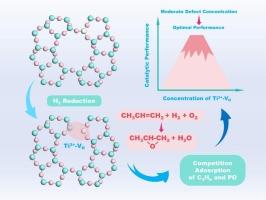TS-1中吸附竞争驱动的火山催化:氢还原定制的Ti3+-VO缺陷浓度的关键作用
IF 6.5
1区 化学
Q2 CHEMISTRY, PHYSICAL
引用次数: 0
摘要
采用一种新的氢介导热还原策略将Ti3+-VO缺陷引入TS-1中,使其不受外源元素污染。通过调整还原条件来精确调整缺陷浓度,研究了缺陷浓度对丙烯氢氧环氧化反应的影响。XPS和EPR证实了Ti3+和氧空位的形成。同时,XRD、FT-IR、N2-BET均显示TS-1的MFI结构和孔隙度无明显变化。原位漂移和动力学实验表明,Ti3+-VO缺陷同时促进丙烯和PO的吸附,低缺陷浓度下丙烯吸附为主,高浓度下PO吸附为主,导致催化活性与Ti3+-VO缺陷浓度呈火山状关系。因此,最佳缺陷浓度的TS-1可以显著提高HOPO反应中丙烯转化率、PO选择性和PO生成率。这些发现强调了精确缺陷工程对优化TS-1催化活性的重要性本文章由计算机程序翻译,如有差异,请以英文原文为准。


Adsorption-competition driven volcano catalysis in TS-1: the critical role of Ti3+-VO defect concentration tailored by hydrogen reduction
A novel hydrogen-mediated thermal reduction strategy is employed to introduce Ti3+-VO defects into TS-1 without foreign element contamination. Defect concentrations are precisely tuned by adjusting reduction conditions, and their impact on propylene epoxidation with hydrogen and oxygen (HOPO) was investigated. The formation of Ti3+ species and oxygen vacancies is confirmed by XPS and EPR. Meanwhile, XRD, FT-IR, and N2-BET indicated no significant alterations to the MFI framework and porosity of TS-1. In-situ DRIFTS and kinetics experiments revealed that Ti3+-VO defects simultaneously promoted the adsorption of both propylene and PO, with propylene adsorption dominating at low defect concentrations and PO adsorption dominating at high concentrations, causing a volcano-shaped relationship between catalytic activity and Ti3+-VO defect concentration. Consequently, TS-1 with optimal defect concentration can significantly enhance propylene conversion, PO selectivity, and PO formation rate in HOPO reaction. The findings highlight the importance of precise defect engineering for optimizing the catalytic activity of TS-1.
求助全文
通过发布文献求助,成功后即可免费获取论文全文。
去求助
来源期刊

Journal of Catalysis
工程技术-工程:化工
CiteScore
12.30
自引率
5.50%
发文量
447
审稿时长
31 days
期刊介绍:
The Journal of Catalysis publishes scholarly articles on both heterogeneous and homogeneous catalysis, covering a wide range of chemical transformations. These include various types of catalysis, such as those mediated by photons, plasmons, and electrons. The focus of the studies is to understand the relationship between catalytic function and the underlying chemical properties of surfaces and metal complexes.
The articles in the journal offer innovative concepts and explore the synthesis and kinetics of inorganic solids and homogeneous complexes. Furthermore, they discuss spectroscopic techniques for characterizing catalysts, investigate the interaction of probes and reacting species with catalysts, and employ theoretical methods.
The research presented in the journal should have direct relevance to the field of catalytic processes, addressing either fundamental aspects or applications of catalysis.
 求助内容:
求助内容: 应助结果提醒方式:
应助结果提醒方式:


